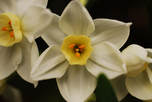|
Ozark Green Thumb BCMG Monthly e-Newsletter |
|
|
 I’ve always liked flower bulbs and especially enjoy forcing them to bloom. One of the easiest bulbs to force is the Paperwhite Narcissus (Narcissus tazetta). Unlike most daffodils, this species requires no chilling to flower. To the daffodil fancier, these bulbs are called the "polyanthus group" -- literally "many flowers." All tazettas have a number of blooms at the end of the scape, not just one as seen in the common daffodil. The cultivars can be divided into three groups; the bi-colors, the doubles and the whites. The name paperwhite narcissus is best used for the white group. Ziva, a selection developed by an Israeli breeder in the 1970s, is the most common. The bulbs and foliage are typical for daffodils in general. Flowers are all white and about the size of quarter, but borne in a cluster with up to a dozen blossoms. Inside the field of six white petals sets a small white cup. The name "tazetta" in Italian means "small cup". All paperwhite narcissus have a strong fragrance, but Ziva’s is particularly strong. Many consider it too strong, a kind of musky sweetness. Paperwhite narcissus is the oldest and most widely distributed of the genus. They originated in the Mediterranean region and adjacent areas of central Asia, but were an early item of commerce. They arrived in China during the Late Sung period, about 1,000 years ago, probably introduced by Arab traders. They became intimately associated with the Chinese New Year celebrations, because they can be bloomed easily in January. Our custom of forcing paperwhite narcissus in a bowl of gravel filled with water is a Chinese custom. The Chinese name for the flower is shuixian, and translates as "water fairy". But, think of it as an assemblage of Daoist deities associated with water, not cute Tinker Bell-like fairies of Western folklore. As a symbol, the flowers are supposed to be the purveyor of great happiness. During the late Victorian period, Chinese art and style seemed quite popular. During the late 1800s the Dutch, always looking for new categories of bulb crops as fashions change, began growing the polyantha narcissus in large numbers. During the late Victorian period, Chinese art and style seemed quite popular. During the late 1800s the Dutch, always looking for new categories of bulb crops as fashions change, began growing the polyantha narcissus in large numbers. They made many introductions of new hybrids and promoted the idea of forcing these bulbs indoors in the Chinese fashion to the Victorian ladies of the day. But, with the opening of WW I, interest in tazettas waned and no new cultivars were introduced. Tazettas are commonplace in California where they are often called Chinese sacred lilies. Most of these early Chinese immigrants were from Fujian Provenance (on the mainland opposite Taiwan), which also was where the bulbs were produced for the Chinese New Years festivities. I usually don’t grow my paperwhites in gravel, but use shallow bulb pans. To create a nice display, I crowd the bulbs together in the pot, often even planting the bulbs in two layers, one atop the other. They are very responsive to temperature, but too-warm temperatures cause them to stretch. To avoid the stretch problem as much as possible, I pot my bulbs in mid- to late October and leave them on the patio. If the temperature goes below 28 degrees, I bring them in. I only bring the pots inside when they are in full bloom, at which time the stretching problem continues. If I were better organized, I would set them outside at night to reduce stretch. If they get too top heavy, cut the stems for cut flowers. Paperwhites are hardy throughout Arkansas, but because they lack winter dormancy, the leaves begin to grow in the fall. Cold winter temperatures singe the leaves, and when they bloom in the spring, the flowers are attractive but the foliage looks pretty rough. By: Gerald Klingaman, retired
Extension Horticulturist - Ornamentals Extension News - January 14, 2005
0 Comments
Leave a Reply. |
Archives
April 2022
|
|
